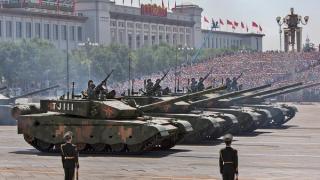In April 2017 a joint centre for advanced science and technology research was launched at the University of Technology, Sydney. The partner and funder is the China Electronics Group Corporation (CETC), one of China’s largest state owned-enterprises.
Beijing’s influence in Australia has long caused unease and prompted difficult questions. Our relations with China are vital to our economy and future prosperity. But as Beijing’s overt and covert influence continues to increase, tougher decisions will need to be made about how to navigate the relationship, particularly when it comes to engaging with political actors such as China’s government-controlled companies.
China is playing an increasingly large role in our strategic science and technology sector. This, and investment in the sector from other overseas governments, needs to be debated. Because as Australia seeks to defend itself from cyber espionage and hi-tech military advancements occurring around the world, some of our organisations may be unknowingly aiding the very same overseas state actors, putting Australia’s national security at risk. This is why the new partnership with CETC should pique public interest.
It is not remarkable that a Chinese state-owned enterprise, or its subsidiary, is funding an Australian university by as much as “$20m over five years”; this has happened before and UTS has been transparent about the funding sources behind this latest international partnership.
What is concerning is that this partnership will “gradually extend to include other Australian and Chinese universities as well as the CSIRO, creating an international innovation hub for IET [Information and Electronics Technologies] innovation”. The scientific and technological areas the new joint-centre will focus on – artificial intelligence, autonomous systems and quantum computing – are dual-use technologies that are also at the forefront of military modernisation.
CETC, an organisation with some 140,000 employees, is a broad church and includes solar power technology, consumer electronics and infrastructure design.
But CETC is also one of the largest and fastest-growing defence companies in China and it has a close relationship with the People’s Liberation Army (PLA). In fact CETC has described itself as “one of the top 10 military industry groups controlled directly by the central government”.
It specialises in the research, development and production of large-scale electronic systems and operates 15 defence laboratories and six defence technology application centres across China. While CETC was formed in 2002, its attached research institutes are some of the oldest in China and are responsible for the country’s most significant advances in defence electronics, including the systems for the “Two Bombs and One Satellite” initiative “that gave China its first nuclear bomb, guided missile, and geo-orbital satellite”.
Today, CETC is at the heart of China’s efforts to further “civil-military integration” in an effort to develop dual-use technologies that will modernise the PLA and China’s state security apparatus. As warfare becomes more information-oriented and networked, technologies that are critical to the civilian, military and security sectors continue to blur. For example, the radar system for the KJ-500, the PLA’s new airborne early warning and control aircraft, was designed at CETC’s No 38 Research Institute using civilian technology. Quantum computing and mechanics is also an example of where civilian and military uses continue to converge. China’s much hyped advances in “quantum radar” in late 2016 were developed at CETC’s No 14 Research Institute.
CSIRO’s cooperation with CETC started well before the UTS agreement. While information is limited, it appears that the first partnership between CETC and CSIRO began in 2007 when the two reached a deal to commercialise CSIRO’s wireless technologies in China.
The CSIRO is not involved with CETC’s No 38 or No 14 Research Institutes, rather it appears they have been working with CETC’s No 54 Research Institute. CETC 54 is heavily involved in military application research in telecommunications, underwater acoustic sensors, satellite tracking, jamming military communications, intelligence and reconnaissance and unmanned systems. Patents and conference papers also indicate research into swarming UAVs (drones) and communication redundancies in the event of “enemy anti-satellite attacks”.
CETC 54 and PLA officials regularly co-author research papers.
More concerning, however, is that for the past 10 years the US Department of Commerce has listed CETC 54 as a “military end-use” entity. The Australian Defence Department’s own export compliance checklist refers Australian organisations to the above US government entity list. While electronics, telecommunications and information security are on Australia’s list of sensitive dual-use goods and technologies, there is no public record of a similar registry of companies in Australia.
Essentially the US system means that any trade or ventures with CETC 54 are subject to review by agencies of the US government because of the institute’s work on military hardware and systems in China. Specifically, technologies and systems that could contribute to ballistic missile systems, space launch vehicles, unmanned air vehicles, cruise missiles and various drones are restricted and subject to review.
In 2010 two Chinese nationals were convicted and sentenced to jail time in the US for selling electronics that had electronic warfare, military radar and missile guidance system applications to CETC.
As part of the partnership between CSIRO and CETC, Australia’s national science organisation transferred its advanced wireless antenna technology to CETC for an upfront free. While not reported, given the subject matter, it is likely CSIRO was dealing with CETC 54. In 2008 CETC 54 won the rights to build a prototype antenna for CSIRO’s bid for the Square Kilometre Array, completing the manufacturing and installation of the 36 dishes in 2015 for $9.9m. CETC 54 design went on to win the SKA competition, a decision that caused some disquiet in the Australian media at the time.
Since at least 2015 CSIRO and CETC 54 have been funders of research programs within UTS’s Global Big Data Technology Centre. A number of former award-winning CSIRO scientists have jumped ship to work in the centre. Other partners and funders include the Australian Department of Defence (through the Defence Science and Technology Group), Huawei, the Chinese Academy of Sciences, Microsoft and Nokia.
Australia’s science agencies have long been key espionage targets for a range of overseas governments. In 2015 the ABC revealed that China was behind a “massive cyber attack” on the Bureau of Meteorology. More recently concerns were raised by scientists because of plans to install Chinese-owned technology on an ANU-based supercomputer used by universities and government departments including CSIRO, Geoscience Australia and the Bureau of Meteorology. In 2013, a Chinese scientist was referred to the AFP for alleged spying activities at CSIRO. However, he had already left the country.
Given this reality, collaboration between CSIRO and CETC 54 raises the question of whether the relationship underwent the appropriate security checks one would expect when the Australian government’s foremost science and technology department is collaborating with a state-owned (and controlled) defence contractor. CSIRO works across numerous technology areas, the majority of which rest on international collaboration and exchange. But it is also involved in some strategically sensitive technology advancement that has military applications. For example, at the newly founded UTS research centre that CSIRO and CETC are members of, one of the focus areas is artificial intelligence, a growing and critical element of new unmanned military systems.
These dual-use technology areas, such as machine learning and big data science, are also playing important roles in the advancement of state security and surveillance, a significant element of CETC’s enterprise.
It has been reported that CETC has been asked to branch out into “public security”, with the Chinese Communist party instructing the state-owned enterprise to develop big data software to predict terrorist attacks on the “basis of job records, financial background, consumption habits, hobbies and data from surveillance cameras”. Based on the UTS Global Big Data Technology C capability statement it appears video surveillance and big data modelling are core research areas.
One also needs to ask whether it’s wise for Australia’s peak science department to be involved in a decade-long partnership with a Chinese state-owned enterprise responsible for some of the same electronic and military technologies our defence force, public service and Australian businesses work hard to protect themselves from.
On the other hand, as La Trobe University professor Nick Bisley has pointed out, funding for Australian universities and research institutes is drying up and Australian research groups are spending more time than ever forming international partnerships and identifying alternative sources of funding, including from overseas governments.
The Chinese government is a vital economic and cultural partner for Australia and it will always be a natural source for such funding. But it is also not our security ally. Its government bureaucracy, complicated state-owned enterprise structure and civil society operate under very different rules from those that govern our business and NGO community. This should never stop engagement – Australia needs a cooperative and stable relationship with China that deserves our focus and a continued investment of public and private resources. Our relationship with China, which will always have its ups and downs, will define our future prosperity.
But it also means transparency – particularly from our public service, academic institutions, media and politicians – is vital.
Neither CSIRO or UTS is breaking any rules here. But in their collaboration with CETC, both fail to mention the elephant in the room. They are not dealing with a state-owned hi-tech enterprise. They are dealing with a state-owned hi-tech military enterprise. There’s a big difference.
If relationships like that of CSIRO-CETC 54 are the future, let’s hear far more about it. Importantly, and to start with, let’s hear an argument from the Australian government as to why collaboration between CSIRO and Chinese state-owned defence contractors is so valuable to the Australian scientific community that taxpayers’ funds should continue to be invested in it, despite the obvious security risks and the fact that technology produced – from advanced cyber intrusion detection systems to large-scale video surveillance – will certainly end up benefiting China’s public security apparatus, including the PLA – a key CETC customer. Because as it stands, with a lack of clarity and no such argument available, it’s hard not to judge that this all appears to be a bridge too far.






